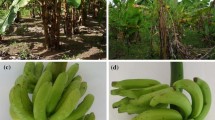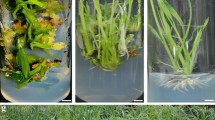Summary
Eleven primary trisomics of rice, variety Nipponbare, were subjected to anther culture. The 12th trisomic did not produce normal anthers. A total of 3,734 plants were obtained, which were examined morphologically at the seedling stage in the greenhouse. A number of plants appeared in the progenies of ten trisomics which had unique morphological features. The frequency of these variant types differed among different progenies. Cytological observations revealed that 43 variant plants in the progenies of nine trisomics had 13 chromosomes (n + 1), and 56 were tetrasomics (2n = 26). The tetrasomic plants in the progeny of a trisomic were morphologically identical. Similarly, n + 1 plants in the progeny of a trisomic were also identical. Plants with 23, 25, 36, 39, and 73 chromosomes were also obtained. Results show that valuable aneuploids such as n + 1 and 2n + 2 can be obtained in the anther-culture-derived progenies of trisomics.
Similar content being viewed by others
References
Chandrasekharan P (1952) The occurrence of barren tillers in a heterozygous rice. Madras J Agric 39:605–610
Chang TT (1964) Present knowledge of rice genetics and cytogenetics. Int Rice Inst Tech Bull 1, Los Banos, The Philippines
Chu QR, Zhang ZH, Cao YH (1985) Cytogenetical analysis on aneuploids obtained from pollenclones of rice (Oryza sativa L.). Theor Appl Genet 71:506–512
Hu CH (1968) Studies on the development of twelve types of trisomics in rice with reference to genetic study and breeding program. J Agric Assoc China 63:53–71 (in Chinese with English summary)
Iwata N, Omura T (1984) Studies on the trisomics in rice plants (Oryza sativa L.). VI. An accomplishment of trisomic series in japonica rice plants. Jpn J Genet 59:199–204
Iwata N, Omura T, Nakagahra M (1970) Studies on the trisomics in rice plants (Oryza sativa L.). I. Morphological classification of trisomics. Jpn J Breed 20:230–236
Karibasappa BK (1961) An auto-triploid of rice and its progeny. Curr Sci 30:432–433
Katayama T (1963) Study on the progenies of autotriploid and asynaptic rice plants. Jpn J Breed 13:83–87
Khush GS (1973) Cytogenetics of aneuploids. Academic Press, New York
Khush GS, Singh RJ, Sur SC, Librojo AL (1984) Primary trisomic of rice: Origin, morphology, cytology, and use in linkage mapping. Genetics 107:141–163
Kurata N, Omura T (1978) Karyotype analysis in rice. I. A new method for identifying all chromosome pairs. Jpn J Genet 53:251–255
Mattingly CF, Collins GB (1974) The use of anther-derived haploids in Nicotiana.III. Isolation of nullisomics from monosomic lines. Chromosoma 46:29–36
McCouch SR, Kochert G, Yu ZH, Wang ZY, Khush GS, Coffman WR, Tanksley SD (1988) Molecular mapping of rice chromosomes. Theor Appl Genet 76:815–829
Metz SG, Sharma HC, Armstrong TA, Mascia PN (1988) Chromosome doubling and aneuploidy in anther-derived plants from two winter wheat lines. Genome 30:177–181
Nayar NM (1973) Origin and cytogenetics of rice. Adv Genet 17:153–292
Niizeki M, Kita F (1975) Production of aneuploid plants by anther culture in Nicotiana tabacum L. Jpn J Breed 25:52–58
Niizeki M, Hayashi H, Saito K (1984) Production of disomic haploid by anther culture of a series of trisomic plants in Nicotiana sylvestris. Jpn J Breed 34:1–8
Oono K (1975) Production of haploid plants of rice (Oryza sativa) by anther culture and their use for breeding. Bull Natl Inst Agric Sci Ser D 26:139–222 (in Japanese with English summary)
Ramanujam S (1937) Cytogenetical studies in the Oryzae. II. Cytological behaviour of an autotriploid in rice (Oryza sativa). J Genet 35:183–221
Sampath S, Krishnaswamy V (1948) A chromosome deficient paddy type. Curr Sci 17:271–272
Sen SK (1965) Cytogenetics of trisomics in rice. Cytologia 30:229–238
Seshu DV, Venkataswamy T (1958) A monosome in rice. Madras J Agric 45:311–314
Wang ZX, Iwata N, Sukekiyo Y, Yoshimura A, Omura T (1988) A trial to induce chromosome deficiencies and monosomics in rice by using irradiated pollen. Rice Genet Newslett 5:64–65
Watanabe Y, Koga Y (1975) Cytogenetic studies on rice and its wild relatives. II. Genetic and cytogenetic studies on the trisomic plants of rice, Oryza sativa L. Bull Natl Inst Agric Sci Ser D 26: 91–138 (in Japanese with English summary)
Yunoki T, Masuyama Y (1945) Investigations on the later generations of autotriploid rice plants. Sci Bull Fac Agric Kyushu Univ 11:182–216 (in Japanese with English summary)
Zhang T, Zhu H, Shu L, Wang S, Li X (1987) Studies on aneuploids from a Chinese indica rice variety. I. Plant morphological part. Acta Genet Sin 14:255–261 (in Chinese with English summary)
Author information
Authors and Affiliations
Additional information
Communicated by G.S. Khush
Rights and permissions
About this article
Cite this article
Wang, Z.X., Iwata, N. Production of n + 1 plants and tetrasomics by means of anther culture of trisomic plants in rice (Oryza sativa L.). Theoret. Appl. Genetics 83, 12–16 (1991). https://doi.org/10.1007/BF00229220
Received:
Accepted:
Issue Date:
DOI: https://doi.org/10.1007/BF00229220




